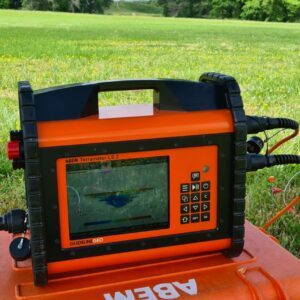Guideline Geo contributes to research at Poverty Point World Heritage Site in Louisiana, USA
Poverty Point is a prehistoric UNESCO World Heritage Site, comprising a series of monumental earthworks, littered with enigmatic finds from spear heads to owl carvings, in rural Louisiana, USA. The site is thought to have been first occupied some 3500 years ago by a society of hunter-gatherers, who traded across huge distances, relying upon the river networks for transport.
The reason why this particular site was chosen as a cultural centre for these people has always been uncertain but a previous GPR survey revealed two, low, mound-like features buried beneath the central part of the site; the site was extensively terraformed to make the flat area within the centre of the earthworks, which may be when these were covered over. Interestingly however, evidence of multiple timber circles that once stood in this central area, shows that the locations of these low mounds were never intruded upon. Seemingly, they were respected by those building the timber structures. Magnetic patterns and extensive soil sampling across the mounds have lead to a suggestion that they could be former Mud Volcanoes and, if so, these strange phenomena may have been what drew people to this spot and led them to settle here.
Jimmy Adcock (ABEM Product Manager at Guideline Geo) went to Louisiana accompanied by Makayla Shoup (part of our technical team focussing on ABEM in the USA) to undertake Electrical imaging (ERT) surveys over the buried mound-like features. The aim of the work, which utilised the ABEM Terrameter LS 2, was to test the argument that these were natural upwellings of material from below, and not just more earthworks built by human-hand.
Could the resistivity characteristics of the mound material be related to what lies beneath, suggesting it has transited upward, rather than being material brought in and piled up? The team also collected chargeability data, looking at the Induced Polarization (IP) effects associated with the material, as there is some suggestion that these effects can be enhanced by microbes feasting on the hydrocarbons coming up to the near-surface.
The surveys were a great success, in no small part due to the accompanying team of Diana Greenlee (University of Louisiana Monroe, and Poverty Point WHS Station Archaeologist), Rinita Dalan (Emeritus Professor at Minnesota State University), and Tad Britt (Chief, Archeology, in the National Center for Preservation Technology and Training, at the National Park Service) who have been working at the site for a number of years. Initial results are very promising and we look forward to sharing more details of this fascinating work later in the year.
This work was supported by a grant from the International Society for Archaeological Prospection’s annual ISAP Fund.














